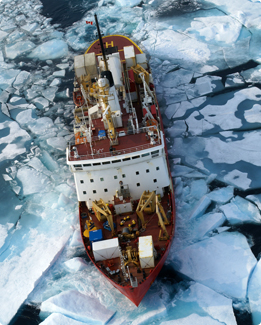University of Manitoba
Cutting edge sea ice research is currently underway at the University of Manitoba’s Sea-ice Environmental Research Facility (SERF). Constructed in December 2011, this facility houses a large experimental saltwater pool (400m2) for sea-ice growth and monitoring activities. Snow cover, energy exchange and other environmental factors can be manipulated to gain understanding of current and future sea ice feedbacks and processes. The SERF Principle Investigators (Dr. Fei Wang, Dr. David Barber, Dr. Tim Papkyriakou and Dr. Soren Rysgaard) define their facility’s scientific objectives as follows:
- To grow sea ice under controlled conditions and with various tracers for the study of its growth, properties, and roles in biogeochemical cycling of contaminants and greenhouse gases.
- To integrate such processes-oriented mesocosm-scale studies with field-based studies, in support of modeling and scaling initiatives to better understand and predict the sea ice environment under a changing climate.
Multiple research projects have already been completed at the site. A remote sensing experiment by Isleifson et al., used radar backscatter analysis to infer physical properties of frost flowers using C-band polarization techniques. Additionally, a pH progression study was completed by Hare et al., to better understand the brine-ice chemical dynamics within a sea ice system (SERF, 2013).
The following video displays growing frost flowers at SERF.
Visit the SERF News Page for upcoming research and media (SERF, 2013).
CanSISE (Canadian Sea Ice and Snow Evolution Network)
CanSISE is a network of eight universities (Toronto, Waterloo, Victoria, Guelph, York, McGill, UBC and UNBC) collaborating with the Climate Research Division (Environment and Climate Change Canada), the Canadian Ice Service and the Pacific Climate Impacts Consortium to investigate Arctic sea ice and snow in Canada. The five year funded project (NSERC, CCAR) is focusing on the following research topics:
- Seasonal to multi-decadal snow and sea-ice prediction and projection,
- Attributing change in snow and sea-ice, and understanding its impacts,
- Improving our understanding of snow and sea ice processes and climate interactions.

For more information, visit the CanSISE website.
Circumpolar Flaw Lead Study
Over 350 researchers contributed to the International Polar Year Circumpolar Flaw Lead study, piloted by Canadian participants. The flaw lead system studied is the open water area between coastal fastened ice and drift ice. This specific environment is important in the study of brine, chemical and biological fluxes, as well as atmospheric and energy processes. The research teams focused on answering the following questions:
- How will climate variability and/or change affect the timing and extent of the flaw lead system through predictable ocean and atmospheric forcing?
- How will reduced sea-ice cover affect seasonal OSA coupling in the flaw lead system?
- How will ecosystem productivity and carbon cycling be altered by a change in the timing of the flaw lead system?
- How will climate variability and/or change affect the adjacent fast ice ecosystem?
- How will changes in the timing of precipitation and the formation and decay of the sea ice affect the contributions of sympagic versus pelagic production to carbon cycling?

The numerous studies were completed using the Canadian Coast Guard ship (Figure 1), the Amundsen within the Amundsen Gulf. The extensive array of research equipment utilized include underwater and ice mooring, microwave profilers, satellite data, buoys, zooplankton tows, (underwater) remote operated vehicles, coring (box and piston) and energy balance equipment. This equipment was used to collect samples from the ice, atmosphere and ocean throughout the duration of the project.
For more information on specific Canadian IPY Projects visit IPY-API.
